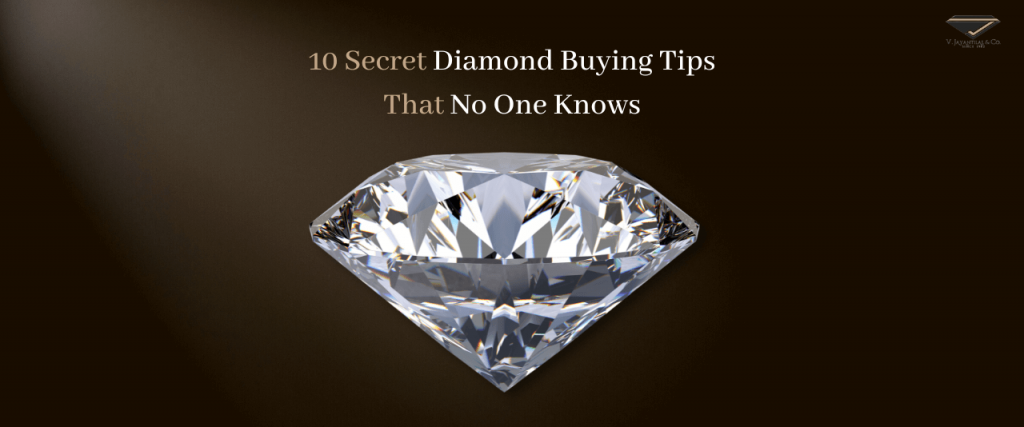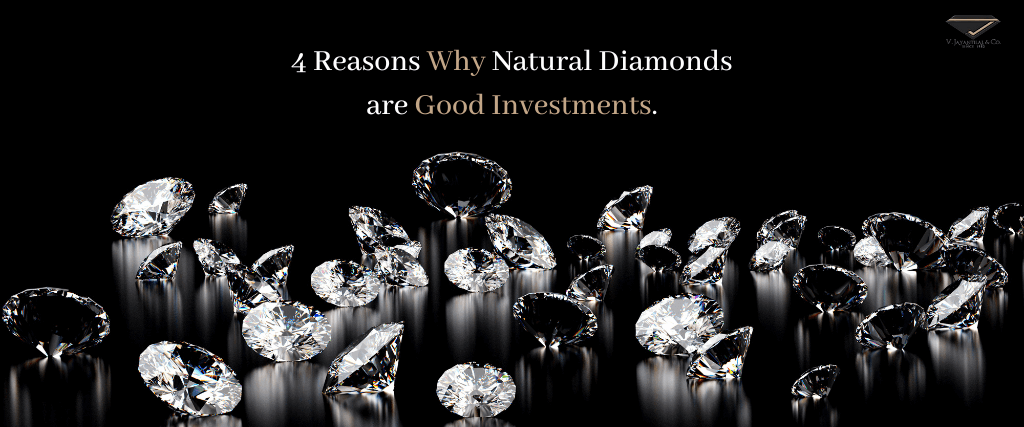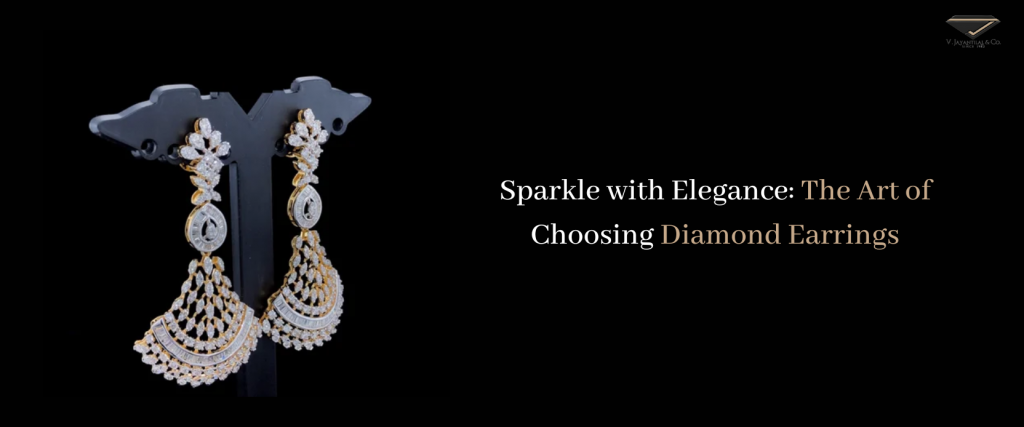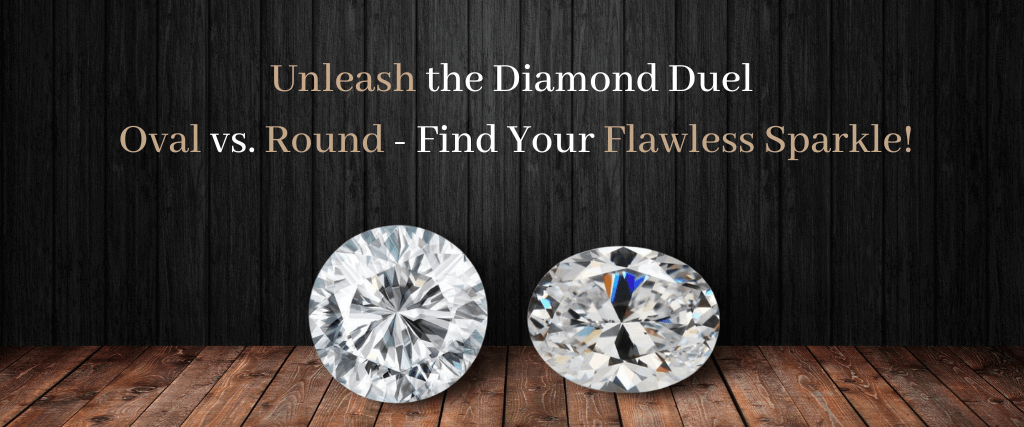Diamond Buying Tips: Shopping for a diamond can be confusing, especially if it's your first time. But if you become knowledgeable about the components that make up a diamond, purchasing one doesn't have to be intimidating. If you’re starting to venture into this world of diamond buying, let this guide help you make educated and stress-free decisions. In this post, we’ve rounded up all the vital diamond aspects you need to understand before buying a diamond. But it's not as difficult as you think.

Here are some diamond buying tips to consider before you go for shopping or buy diamond online.
The first tip from diamond buying tips is to know the 4Cs: color, clarity, cut, and carat weight. Created by the GIA, the 4Cs are the global standard for assessing the quality of diamonds and allow you to compare one diamond to another.
The next stage is to ask yourself, "Which C is the most important to me?" when you are familiar with the meaning of the 4Cs. Prioritising the 4Cs will enable you to swiftly whittle down your search results and find the diamond that's ideal for you. It will also help you work with your budget, knowing which items you are willing to spend more on and which you are willing to compromise on.
Having a basic understanding of these four diamond characteristics will help you have better conversations with your jeweller and give you the vocabulary to ask important questions.
A diamond’s color is a measurement of how white it is. Other stones may have a yellow or brown hue, whereas chemically pure diamonds seem entirely colourless. After a diamond is mined, it is sent to a gem lab, where gemologists grade its color on a scale that begins with D (colorless) and ends with Z (light yellow), with D meaning that a diamond is completely colorless and Z meaning that a diamond has a light yellow or brown color. Less-colored diamonds in this colour range are more uncommon and highly prized. When shopping for a diamond, consider how important color is to you. D-colored diamonds are extremely rare and therefore extremely expensive. Therefore, you might want to think about choosing a less expensive white diamond that will still be stunning but much less expensive.
When talking about a diamond's clarity, the terms "inclusions" and "blemishes" are used interchangeably. Clarity is graded on a scale from flawless to included. Flawless through VS2 Diamonds are generally what is called “eye clean,” meaning the diamond’s flaws can’t be seen by the naked eye. As with all other diamond gradings, the higher the grading, the more expensive the diamond. However, since many diamond faults are small, purchasing a diamond with minor imperfections might still result in a stunning diamond while saving you money. Decide how important perfection is to you before you purchase online.
The diamond's carat weight determines the diamond’s apparent size. In general, a diamond with a larger carat weight is rarer and more expensive, assuming the other Cs are equal. Carat is the most well-known of the 4Cs. However, a lot of people are misinformed and believe that a carat is a measurement of size rather than weight. It's critical to realise that carat does not always correspond to perceived size. So, while a diamond’s carat can give you a general idea of its size, it’s important to also consider its cut, shape, and table measurement when considering the size.
How effectively a diamond interacts with light is dependent on the quality of its cut. A diamond’s proportions, symmetry, and polish determine its brilliance, sparkle, and fire. The form of a diamond, which is a separate diamond quality, is not reflected in the diamond's cut. It’s a grading of how well a diamond was cut. The best diamond cut is excellent, followed in order by very good, good, fair, and poor.
When a diamond has an ideal cut, all the light that enters it is maximized, reflecting and refracting, creating a beautiful sparkle. The majority of the light that enters a diamond with a poor cut is lost via its sides or bottom, giving the diamond a dull appearance. The cut can have a major impact on the beauty of a diamond, so it’s important to keep that in mind when shopping. The cut grade is divided into three parameters: proportions, symmetry, and polish. According to the quality ratings of excellent (EX), very good (VG), good (G), or fair (F), each parameter is evaluated separately.
Diamonds come in various shapes. The most popular and expensive diamond form is the round brilliant cut. Since round diamonds have the highest sparkle, they are quite valuable.
The remaining diamond shapes are called fancy shapes. While the square or rectangular forms, such as the Asscher, are step cuts, others, such as the marquise, pear, and heart, are essentially variations of the round brilliant cut. The most significant influence on a diamond's aesthetic may come from its form. Therefore, take into account which form is most appealing to you aesthetically while choosing your diamond shape. There are different levels of fire and scintillation in every fancy-shaped diamond.
Fluorescence is a marker of how a diamond reacts to UV light. A diamond is regarded as fluorescent if it glows under UV light; otherwise, it is not fluorescent. On a scale from no fluorescence to intense fluorescence, this is rated. The fluorescence of a diamond can often appear blurry, even though it is difficult to perceive with the unaided eye. It's entirely up to you whether you desire fluorescence in your diamonds or not. If you’re unsure about how you feel about diamond fluorescence, you can always compare diamonds with and without fluorescence to see which you find more visually appealing.
Buying Certified diamonds like GIA Certified Diamond by a respected gem laboratory is the safest method. The International Gemological Institute (IGI), Hoge Raad voor Diamant (HRD), and the Gemological Institute of America (GIA) are the three primary gem labs. By clearly stating a diamond's cut, color, clarity, and weight, certificates ensure its high quality and preserve the buyer's investment by enhancing the gem's ability to maintain value over time.
Since a diamond represents a large investment, you should purchase it from a jeweller you can rely on. Your jeweller should be knowledgeable, approachable, and able to explain how to purchase a diamond in straightforward terms. Tip Start by looking for a jeweller who has a degree from a reputable program that is approved globally, like the GIA Graduate Gemologist. A knowledgeable jeweller can help you buy diamonds by explaining the 4Cs of diamond quality and showing you the variations between stones that appear to be identical. They will nudge you to compare how many diamonds fit your price range.
Our only goal at V. Jayantilal & Co. is to do everything in our power to assist couples in reaching a significant life milestone. We always place a premium on education and favour quality over quantity.

Most people don't think about purchasing diamonds until they need to buy an engagement ring, and then the questions begin. Do all engagement rings include diamonds? How can I tell whether a diamond is of high quality? Are Natural diamonds a good financial investment?
It is a wise decision to invest in diamonds because their value remains protected. Unlike other intangible investments, you can make use of this in so many ways.
Especially natural diamonds, which are some of Earth’s greatest assets and have long been valued as precious stones for ages.
The mining, shipping, and insurance costs of diamonds are rising, and that’s why investing here will secure big returns in the long term. Diamond gemstones, once only found in the earth, can now be made in a laboratory environment. But are natural diamonds a better investment than synthetic ones made in a lab? In this blog, we will discuss the reasons why natural diamonds are a good investment.
So, with all this in mind, are natural diamonds a good investment, and will their value grow over time? The answer is almost always yes but with some caveats. The value of most natural diamonds will either increase or remain consistent over time because there is essentially a finite supply of stones within the earth. Lab-grown diamonds have a number of benefits that make them preferable to many people. In addition to having a lower price tag, natural diamonds are generally considered to be more ecologically friendly compared to synthetic diamonds. However, for a number of compelling reasons, lots of people still like natural diamonds. Still, when it comes to choosing between a natural or lab-grown diamond, it all comes down to personal choice and preference. Some people prefer the unique imperfections and characteristics that come with natural diamonds, while others appreciate the precision and consistency of lab-grown diamonds. Ultimately, the decision should be based on what is most important to the individual buyer.
Natural diamond prices don't vary as much as those of other commodities, which is one reason they make wise investments.
Diamonds are unique, due to the fact that they are not impacted by the same economic factors as other commodities. For example, the price of gold is often affected by inflation, but the real diamond price is not.
No matter how the economy is doing, people will always need and demand diamonds, making them a more reliable investment. This is because diamonds are not only used for jewellery but also have industrial applications in cutting and drilling. Additionally, the limited supply of diamonds due to their rarity and difficulty in extraction also contributes to their value as an investment.
An excellent way to gain more value for your money is to invest in real diamonds. Diamonds are also highly liquid assets, meaning they can be easily sold or traded. Additionally, their value tends to appreciate over time, making them a smart long-term investment.
In addition, diamonds are strong and, with proper maintenance, will last a lifetime. They can also appreciate over time, making them a wise investment for the future. Furthermore, diamonds are a timeless and classic choice for jewellery, making them a versatile investment that can be worn and enjoyed for years to come.
Diamonds are extremely durable, which is one of the reasons they make such a great investment. They are the hardest natural materials on earth, which means they can withstand a lot of wear and tear. They also don't tarnish or fade with time.
With proper care of diamond jewellery, diamonds can last forever. That implies that they have the potential to cherish family heirlooms, which might raise their sentimental value. Furthermore, because diamonds are unaffected by inflation or other economic variables, they are not vulnerable to market volatility. This makes them a reliable investment option. Furthermore, diamonds are versatile and can be used in a variety of settings, from engagement rings to high-end Natural diamond jewellery pieces.
In recent years, there's been an increase in the number of people interested in buying natural diamonds. The importance of diamonds as a status symbol and a mark of luxury are a few of the causes behind this.
More and more people are searching for diamonds to purchase in order to show off their wealth as the world gets more prosperous. In addition, the rise of social media has also contributed to the trend, as people are more likely to showcase their possessions online. This has created a desire for unique and eye-catching diamond pieces that can stand out on social media platforms.
Diamonds have a generally high resale value because they may last the longest, compared to other commodities, without losing any of their original quality. And their worth as money never diminishes.
Here are a few more pointers to assist you increase your natural diamond
A diamond is a wonderful investment. It’s beautiful, lasts forever, and carries emotional value. It’s an heirloom that can be passed on from generation to generation. It’s an asset, without a doubt. Here at
V.Jayantilal & Co., we've got you covered. Our jewelry is of the highest caliber, and we offer diamonds that are excellent investments. Our diamonds have always been obtained ethically and responsibly, and they will remain so. You may use them for many years. Contact us right away or go to our website if you have any questions. We are prepared to assist.

Diamond earrings have been more popular in mainstream fashion in recent years. Diamond earrings are the ideal gift for yourself or a surprise present for someone you care about, especially with the simple jewellery style and the stacked earrings trend. Before making any purchases, you must read our guide to buying diamond earrings. Diamond earrings are timeless and provide the ideal amount of sophistication to any ensemble. The beauty of diamond earrings is that they don’t need the perfect dress or occasion. They stand on their merit, enhancing your appearance. So, if you're prepared to expand your collection with a few diamond earrings, you're in the right place.
Here is a complete guide for buying diamond earrings.
Setting a budget that you are comfortable with is crucial when purchasing diamond earrings. To guarantee they are purchasing a high-quality pair that will be treasured and last a lifetime, some customers often put their budget in the thousands rather than the hundreds. Diamond earrings come in a range of prices. It depends totally on what you are willing to spend.
The two most crucial elements to take into account are size and shape. Your face should be proportional to the size of the diamonds. If you have a small face, choose smaller diamonds, like the Opt for larger diamonds Earrings for those with a larger face.
The dazzling round cut is the most preferred option when it comes to shape since it sparkles the brightest. The stone's shape is entirely up to you. Consider alternative forms like the oval, marquise, or pear if you're seeking something distinctive. Princess-cut diamonds are equally popular, while round diamonds are more typical and conventional. Both of these forms offer the most incredible glitter and brightness. Oval and cushion-cut diamonds, on the other hand, are viewed as feminine with an antique flair. Asscher-cut and emerald-cut diamonds are quite geometric in design and also have a very fashionable vintage appearance right now. However, if you’re looking for something more unique and special, consider a heart, marquise, or pear.
Your style, the shape and cut of the stone you select, and the setting you pick will all influence the look of your diamond earrings. Consider the following diamond settings:
Four-Prong Setting: A four-prong diamond setting provides elegance and a timeless charm.
Three-Prong Martini Setting: To achieve a flush setting, three-prong settings are designed to properly and accurately fit the diamond.
Bezel Setting: This diamond earring setting creates a metal perimeter that completely encapsulates the diamond stud, giving it a more modern and uniform look.
Halo Setting: This adds more brilliance to the centre diamond because it reflects off of the smaller halo stones.
The earring back, which is hidden from view while the earrings are worn, is the most neglected component when purchasing diamond earrings. It's up to you to decide which backing would look best with your diamond earrings. Push-backs, friction-backs, and butterfly backs are the most popular types of backs. These are normally quite secure and glide on effortlessly. You may choose threaded or screw-back earrings if you want more stability to hold your earrings in place. Although they physically screw on for maximum security, they can be challenging to use and occasionally aren't as comfy as conventional backs.
Another important factor to consider when investing in a pair of diamond earrings is the quality. The universal method for determining a diamond’s quality is known as the 4Cs Colour, clarity, cut, and carat weight. To achieve a flush setting, three-prong settings are designed to properly and accurately fit the diamond.
Let’s take a crash course in the 4Cs of diamond quality :
They are an essential component of this buying guide for diamond earrings since you will come across them whenever you enquire about any item of diamond jewellery. In keeping with that, it's also important to keep in mind that it is concerning if someone offers to sell you diamond earrings but omits to mention any of the 4 C's.
Make sure any diamond you intend to buy is certified before making any purchases. any is a pretty crucial component of any guide to buying diamond earrings and one you must remember. Diamond certification is provided by specific gemological laboratories from all around the world that confirm the authenticity of a diamond and measure its different qualities, such as the 4 C’s (carat, cut, colour, and clarity).
You may go on and start thinking about the design as soon as you have a budget established for yourself. This includes the diamond cut, the ring setting, or if you want a specific style such as studs, hoops, or chandeliers. Based on their shape and size, there are four basic types of diamond earrings one must own. Each type of earring is charming and beautiful in its own way. Read along to find the perfect pair to suit your style.
Earring styles will depend entirely on your personal preference. Before you begin shopping for diamond earrings, it's a good idea to have one or two specific styles in mind as there are many to pick from. This facilitates (and expedites) your buying process.
Here is a simple tutorial on selecting the right type of diamond earrings to buy.
The metal setting of your diamond earrings is just as important as the diamonds themselves. The most popular metal settings for diamond earrings are yellow and white gold. The white gold setting is best for those who want a more sleek and contemporary look. For individuals who like a more conventional and classic style, yellow gold is the finest option. If you can extend your money, choose platinum for a more contemporary style because it is the most expensive option. But if you want a vintage look, you can get the Diamond Earrings in rose gold.
Now that you have all the know-how on shopping for new diamond earrings, it’s time to shop! The best place to buy diamond earrings is at V. Jayantilal & Co., which is home to jewellery professionals who love helping patrons find amazing new pieces to add to their personal jewellery collections. With this ultimate guide, you’ll be sure to find the perfect pair of diamond earrings to complete your look – all in one place.

Round brilliant-cut diamonds and oval-cut diamonds rose to fame early on and are still in use today. They are a widely popular choice for engagement rings and exquisite jewellery. Whether we're talking about a naturally occurring diamond or a lab-grown diamond, these two diamond cuts both have a beautiful, elegant, and timeless form. Both diamonds work well in a variety of settings and offer a good amount of sparkle. But which should you pick? You can't go wrong with either option; we're here to tell you, but keep reading for a full breakdown of oval vs round diamond.
Oval shape diamond are the ideal choice for any woman, because of their effortless grace and elegance. It is one of the fancy-shaped diamonds and is a beauty to behold. All oval diamonds have an elongated shape, which gives them a classy appearance. It doesn't have standardized length-to-width ratios, which allows the proportions to be chosen according to personal preference. Their shape looks beautiful on any finger and often appears larger than their actual carat size, which makes an oval engagement ring popular. Additionally, compared to other diamond shapes, oval diamonds can display more colour and might have more flaws in the core of the stone.
The most common type of diamond cut is a round cut. Round diamonds have been around for centuries, but it wasn't until the first decade of the 20th century that the cut of the round form was perfected, giving rise to the round brilliant cut diamond, which has 58 facets, or flat cuts. Regarding pure optics and light performance, no shape can match the round brilliant. The round cut beautifully complements both traditional and modern engagement rings, looking great on both. Round-cut engagement rings are available in a variety of designs. With a wide range ranging from solitaire to five-stone settings, everyone may discover a ring that matches their taste.
When it comes to pricing, the 4C's of diamonds are the primary determinants of the price of a diamond. If price is your foremost priority while looking for a diamond, you can buy an oval diamond instead of a round-cut one. In addition, oval diamonds not only appear larger than round diamonds of the same carat weight but typically cost less. Due to their extreme popularity, round-cut diamonds are the most costly. Round-cut diamonds generate the most waste during the cutting process, raising the cost of these stones.
The term "carat weight" describes a diamond's size. Both oval and round diamonds are available in a wide range of carat weights. Choose an oval cut diamond if the size is important. Oval cut diamonds will appear larger than round-cut diamonds of the same carat weight because they have a larger surface area. The table's depth and size are the two most important considerations. The appropriate table percentage for a round brilliant is 54-57%, while the ideal depth percentage is 59-63%. For an oval diamond shape, the appropriate table percentage ranges from 53-63%, while the ideal depth ranges from less than 68%. The fact that oval diamonds seem bigger than round diamonds helps you make the most of your cash. Oval cut diamonds provide the appearance of longer, slenderer fingers better than round-cut diamonds, which nonetheless look stunning on any finger.
Every movement causes a diamond to shine, which is an undeniable burst of brilliance, fire, and scintillation. If sparkle is important to you, then you should choose a round cut diamond instead of an oval cut diamond. How brilliant a diamond is will depend on how well it is cut. The oval diamond is one of the most dazzling among brilliant cuts. The shape and design provide the best possible fire, brightness, and scintillation. Overall, both round and oval diamonds will glitter exquisitely, but a round brilliant is suggested if you want the most brilliance possible.
Naturally, when we talk about shape, we don't just mean the obvious—that round diamonds are round and oval diamonds are oval. Round diamonds will always be exactly that—round. After all, the shape of a circle never changes. Ovals come in a variety of shapes, including fat, wide, long, or slender. With ovals, they can vary in shape—fat, wide, long, or slender. Oval diamonds come in a variety of shapes, much like their shape itself. Therefore, when purchasing a round diamond, you should only consider the table and depth percentage rather than the diamond's form. But you must take into account the diamond's true form when purchasing an oval diamond.
When purchasing oval diamonds, one of the 4Cs to take into account is colour. Round-cut diamonds are more likely than oval cut diamonds to conceal traces of yellow or brown due to their high brilliance and sparkle. Colour isn’t inherently a negative thing in a diamond, but if you pick an oval-cut diamond and want an icy-white diamond, you’ll need to be a bit more mindful of it. Even though round brilliants cost more in general, you may not need to buy such a high colour grade. With oval diamonds, the colour grade is more significant, particularly in the lower "near-colourless" range.
By far, round brilliant diamonds are more popular. This is how the industry has shaped it. There is one oval diamond for every 25 round brilliants. Simply put, more round brilliants are made than other shapes. Oval diamonds are therefore more uncommon. All things considered, compared to other diamond shapes, oval diamonds continue to be a popular option. The oval diamond has ascended to the top of the list in recent years. Following are the current standings: oval, cushion, and round. Any of these choices will be seen as both fashionable and timeless. They are all consistently in demand, with the round brilliant at the forefront.
It is up to you and your tastes whether you choose an oval or round diamond. There is no correct or incorrect shape to select. Both of these diamond forms are timeless, will glitter magnificently, and have elegantly rounded edges that look great on any finger. Choose an oval-cut diamond if you're searching for something a little more distinctive. If you like something more classic, opt for a round-cut diamond.
At V. Jayantilal & Co., a Surat-based diamond company, you will find high-quality diamonds at the best price. There will be a ton of gorgeous, high-quality selections available for you to select from.
Please feel free to contact us if you have any questions. We are always happy to help lead you in the right direction and make your shopping experience informative and headache-free.

